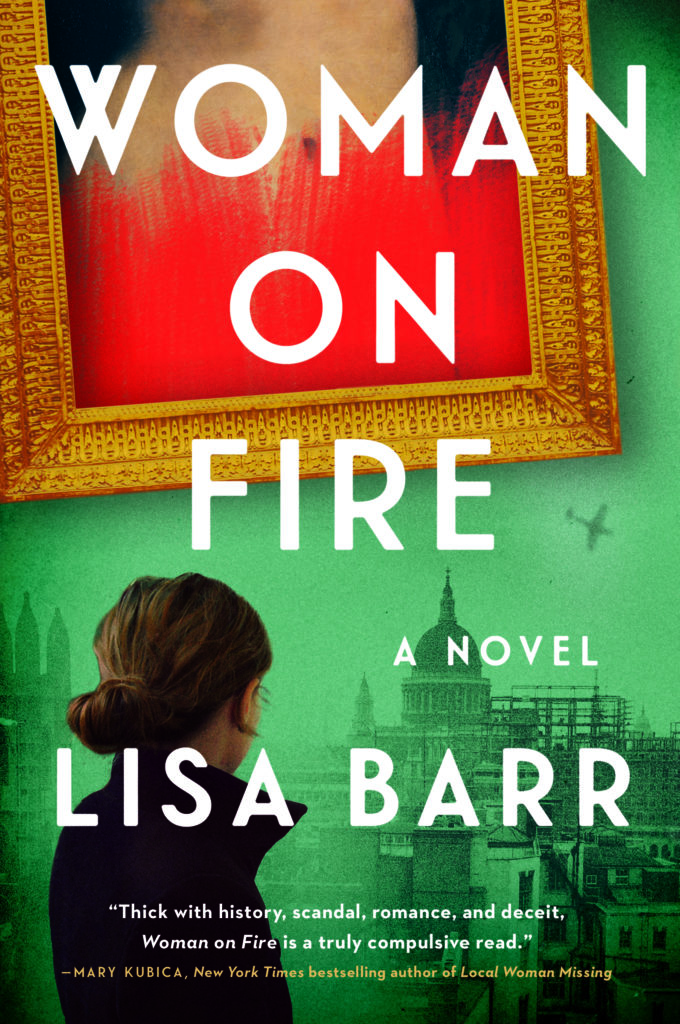Award-winning author Lisa Barr is back in the game with her latest book, Woman on Fire, a thrilling novel sure to become a bestseller. How big is the buzz on this book? Hollywood legend Sharon Stone has already optioned the rights for a film adaptation that she will produce and star in, and both Katie Couric and Buzzfeed have it on their Must-Read Book Lists for 2022.
Barr is no stranger to the hit novel; her previous books Fugitive Colors (2013) and The Unbreakables (2019) each delivered compelling characters and narratives, revolving around Jewish protagonists and the power of art to heal… or corrupt. A journalist by trade (Medill School of Journalism, WGN, Chicago Tribune, Today’s Chicago Woman, Jerusalem Post, Chicago Sun-Times), it’s no surprise that Barr approaches her writing process fueled by a plethora of research.
“I researched Nazi-looted art for four years before writing Fugitive Colors; I was a journalist by day, and a fiction writer by night,” shares Barr. “I find that I’m drawn to art…maybe in my last life I was an artist living in Paris in the 1920s. In Woman on Fire, I wanted to have a young journalist as part of the story. Each of my books has a “news nugget” that’s tied in; this time it’s the Munich Art Hoard , which was discovered in 2012.”

The Munich Art Hoard is the shocking true story of a reclusive German man (the son of noted art historian and dealer Hildebrand Gurlitt) discovered to be holding on to thousands of works of stolen artwork, including works by Degas, Gauguin, Picasso, Rodin, Chagall, Munch, and Kandinsky, among others. He stored the artwork throughout his apartment, including in the unused oven.
“Is it a crime if you steal from the robber? I knew I wanted to use that as a launchpad for the story,” says Barr.
The main character, a passionate and persistent young journalist named Jules Roth, is a whiz at research, and driven to seek out the truth. These are traits that Barr well understands. She is the daughter and granddaughter of Polish Holocaust Survivors, who taught her not to back down from harder things; that despite obstacles and tragedy, you can — and must — begin again. Yet Barr knew nothing of the history of the Third Reich’s obsession with art until she visited a traveling exhibit on “Degenerate Art” at the Art Institute of Chicago while on assignment 30 years ago. Haunted by what she learned about the confiscation, destruction, and looting of more than half a million works of art from galleries, artists, museums, and Jewish collectors, she found inspiration for her two of her novels. It was, Barr says, “a robbery on the grandest scale that began in Germany and spread to become an all-encompassing cultural pillaging of Europe’s treasures.”
Hitler, who thought himself an artist, painted classically and found only rejection for his works. He became obsessed with hatred for the German Expressionists, who painted with vivid colors and chaotic brushstrokes. This free-wheeling, emotional approach to art was against everything that the Third Reich stood for, so was consequently demonized and violently put down. The fictional (and eponymous) painting at the center of “Woman on Fire” epitomizes the passion of German Expressionism, and the danger it posed to the Nazis.
“A historically accurate side to the story was Hitler destroying and looting those paintings,” says Barr. “The artists were killed, but the profits from those paintings [helped fund] the German war effort. They were sold to major museums around the world. The Nazis were good about getting the paper trail to back it up, with fake tax claims, forged signatures, and worse. There are many museums that still hang stolen artwork, and the black market for stolen art and forgeries is all very real.”

Barr, who lives in Deerfield with her husband and three daughters, is already deep into writing her next book about an actress in WWII Poland during the Warsaw Ghetto uprising. “I love the present- day bringing in of past scenarios — bringing in real issues through the back door of historical fiction so that readers can connect, understand, and learn from the story,” says Barr. “It makes an impact.”
Barr has a full docket of upcoming author events both in-person and virtual, including a book launch premiere (register here) at the Illinois Holocaust Museum & Education Center in Skokie, and a virtual “Unpacking the Book” event (“Art, Assimilation, and Reclaiming a Stolen Legacy”) presented in partnership with Tablet Magazine and the Jewish Museum on Monday, April 11 (free tickets available here). The book was released March 1 and is available at your local bookstore.
More from Better:
- 14 New Chicago Restaurants to Check Out This Winter 2022
- New in Town: Chic Salads, a Zero Waste General Store, Indoor Putting Greens, and a Gym With a Movie Theater Full of Treadmills
- New Trier Alumna’s Marilyn Monroe ‘Crusade’ Is Now a CNN Documentary Series

Julie Chernoff, Better’s dining editor since its inception in 2007, graduated from Yale University with a degree in English — which she speaks fluently — and added a professional chef’s degree from the California Culinary Academy. She has worked for Boz Scaggs, Rick Bayless, and Wolfgang Puck (not all at the same time); and counts Northlight Theatre and Les Dames d’Escoffier International as two of her favorite nonprofits. She currently serves on the national board of MAZON: A Jewish Response to Hunger, an advocacy group addressing hunger issues in the U.S. and Israel for the nearly 46 million people — veterans, children, seniors, tribal nations, and more — who go to bed hungry every night.
